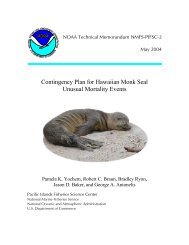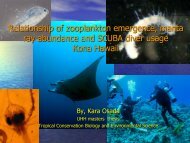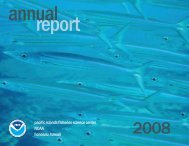Shark Predation on Hawaiian Monk Seals - Pacific Islands Fisheries ...
Shark Predation on Hawaiian Monk Seals - Pacific Islands Fisheries ...
Shark Predation on Hawaiian Monk Seals - Pacific Islands Fisheries ...
You also want an ePaper? Increase the reach of your titles
YUMPU automatically turns print PDFs into web optimized ePapers that Google loves.
pups in daylight hours (NMFS, 2003; NMFS, 2004; Harting et al., in prep.). Additi<strong>on</strong>al<br />
observati<strong>on</strong>s of shark activity were also recorded in 1997–1999 and 2004–2007.<br />
Observed Trends in <str<strong>on</strong>g>Shark</str<strong>on</strong>g> <str<strong>on</strong>g>Predati<strong>on</strong></str<strong>on</strong>g><br />
R. Dean Grubbs and C. Meyer summarized informati<strong>on</strong> about Galapagos and tiger shark<br />
movement and behavior, especially at FFS, at Workshop II (detailed in Secti<strong>on</strong> I). The<br />
following provides additi<strong>on</strong>al informati<strong>on</strong> about the species’ behavior at FFS.<br />
Galapagos sharks have been implicated as m<strong>on</strong>k seal pup predators as derived from direct<br />
observati<strong>on</strong>; gut c<strong>on</strong>tents of tiger sharks c<strong>on</strong>taining seals of unknown age suggest their possible<br />
involvement. Galapagos sharks are the <strong>on</strong>ly shark species observed by HMRSP to be near<br />
pupping sites charging, chasing, biting and killing preweaned pups. (NMFS, 2003; NMFS,<br />
2004; NMFS, 2005; NMFS, in prep.; Harting et al., in prep.; NMFS, unpubl. data). Based <strong>on</strong><br />
tagging and other distinguishing features of individual sharks during the peak times of shark<br />
predati<strong>on</strong> (1998), a minimum of 14 identified Galapagos sharks were observed patrolling or<br />
pursuing preweaned pups at Trig Islet (NMFS, 2009). One of the previously sighted and tagged<br />
Galapagos sharks from 1998 was again sighted around Trig Islet during the 1999 pupping<br />
seas<strong>on</strong> and was identified with the killing of a preweaned pup that year (Harting et al., in<br />
prep.).<br />
Globally, Galapagos sharks are resident insular, typically found in depths of 150 m. They feed<br />
primarily <strong>on</strong> cephalopods, elasmobranchs, and reef, demersal and bottom fishes (Vatter, 2003).<br />
However, it has been reported that pinnipeds have been included in the Galapagos shark diet<br />
(Compagno, 1984). Shallow water predati<strong>on</strong> by sharks, especially during dusk and nocturnal<br />
hours, has also been described in the literature (Castro, 1983). Results from insular shark<br />
surveys in the NWHI at 10 major shallow reefs (< 40 m) (2000–2002, 2004, 2006, 2008)<br />
indicate that Galapagos sharks are not comm<strong>on</strong>ly found in shallow areas (NMFS, 2009b).<br />
Together, these findings suggest preying <strong>on</strong> pinnipeds at shallow depths is not comm<strong>on</strong> but it is<br />
within the behavioral repertoire of the shark species.<br />
Tiger sharks are opportunistic predators that c<strong>on</strong>sume a diverse array of taxa including marine<br />
mammals (Meyer et al., 2009). A clear <strong>on</strong>togenetic shift in diet occurs in both increasing prey<br />
diversity and increasing prey size as shark size increases for Galapagos and tiger sharks<br />
(Wetherbee et al., 1996; Meyer et al., 2009). Gut c<strong>on</strong>tents of 3 tiger sharks out of 23 caught in<br />
1977 at FFS c<strong>on</strong>tained m<strong>on</strong>k seals of unknown age; no seal remains were found in the gut<br />
c<strong>on</strong>tents of the 2 Galapagos sharks caught (Taylor and Naftel, 1978). No seal remains were<br />
found in the gut c<strong>on</strong>tents of 4 tiger sharks and 11 Galapagos sharks caught in a 1998 study<br />
(Vatter, 2003).<br />
Other trends noticed in shark predati<strong>on</strong> patterns at FFS include: (1) a general decline from the<br />
1997–1999 peak to 6–11 pups lost per year, (2) a shift in shark activity from centering around<br />
Trig and Whaleskate Islets to additi<strong>on</strong>al islets within the atoll (East, Gin and Round Islets) (Fig.<br />
5), and (3) an increasing predati<strong>on</strong> focus <strong>on</strong> the youngest pups (Fig. 6). The decline in shark<br />
predati<strong>on</strong> and greater distributi<strong>on</strong> of predati<strong>on</strong> may be a result of a combinati<strong>on</strong> of any of the<br />
27
















